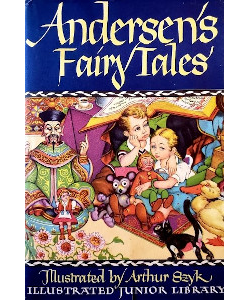Andersen's Fairy Tales

Author:
Hans Christian Andersen ![]() Information you may want to know about this author
Information you may want to know about this author
Illustrator:
Arthur Szyk
Original language:
Danish
Translator:
Mrs. E. V. Lucas, Hertha Pauli
Publication:
1945 by Grosset & Dunlap
Genre:
Anthology, Classic Literature, Fairy Tales, Fiction, Folk Tales
Series:
Illustrated Junior Library (Short w/ DJ) ![]() Members Only
Members Only
Pages:
343
Current state:
Basic information has been added for this book.
It is under consideration and will be updated when it is evaluated further.
Book Guide
Search for this book used on:
While fairy tales, adapted from the folklore of many lands, seem always to have been with us, it was actually a young Dane named Hans Christian Andersen, who only a little over one hundred years ago began to create and write the fairy tale as as we know it today. Such favorites as The Steadfast Tin Soldier, The Ugly Duckling, The Snow Queen are entirely the creation of the man whose own life reads like a fairy tale, and who died in Copenhagen in 1875.
One reason for the popularity of Andersen's stories among children is that he never assumed a condescending attitude toward his readers. He never "wrote down" to them.
In this new edition, in which the selection has been made with the help of wise and understanding authorities on children's literature, the translations by Mrs. Lucas and Mrs. Paull have faithfully retained the dramatic qualities and simple style of the stories as they were first written.
Arthur Szyk's brilliant illustrations make this a memorable edition of Andersen's Tales. Drawn exclusively for The Illustrated Junior Library.
From the dust jacket
To view an example page please sign in.
Resource Guide
Episode 70: Why Read Fairy Tales?
Released in 2020 by The Literary Life
Available formats: Streaming Audio
Length: 1 hr. 29 min.
View on the The Literary Life site
"Angelina Stanford and Cindy Rollins tackle the topic of fairy stories, discussing the what, why and how of reading them. Angelina shares the distinctive characteristics of fairy stories in contrast to other types of stories, such as myths. They deal with the question of whether fairy tales are 'escapist', the influence of the Grimm brothers scholarly work on interpreting fairy stories, and allowing the story to unveil its deeper truths without forcing meaning onto it.
Angelina gives an illustration of how to see the gospel messages in fairy tales by talking us through the story of Sleeping Beauty. She refutes the ideas that fairy tales are about human romance or are misogynistic. She also highlights some of the Enlightenment and Puritan responses to fairy tales that still linger with us today. Cindy and Angelina also discuss some common concerns such as the magical, weird, or scary aspects of fairy tales. Angelina also makes a distinction between folk tales, literary fairy tales, and cautionary tales."
Find This Book
Search for this book used on:




